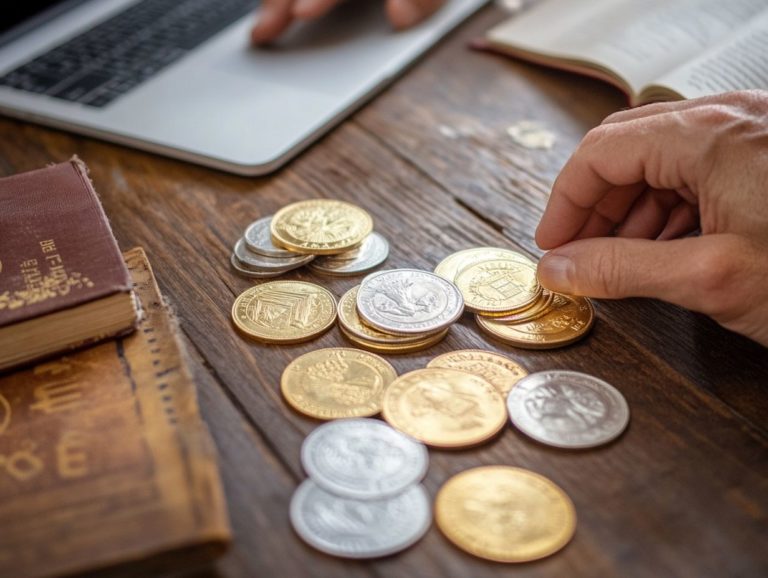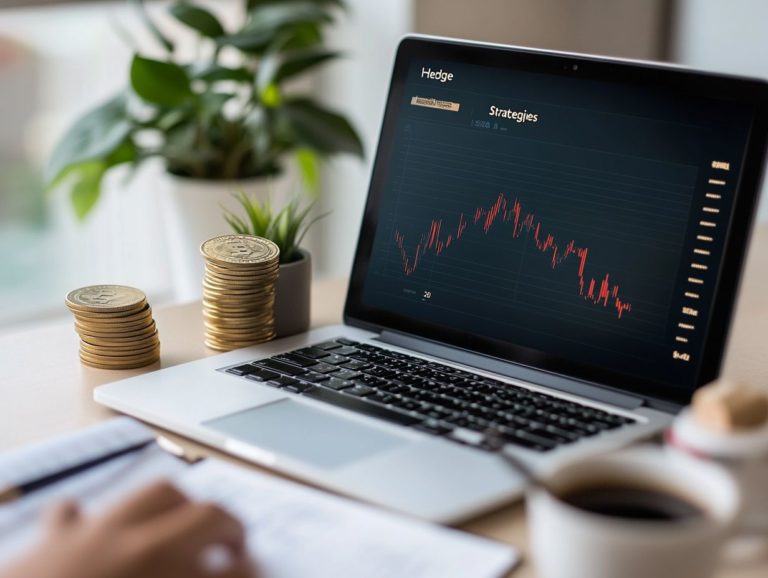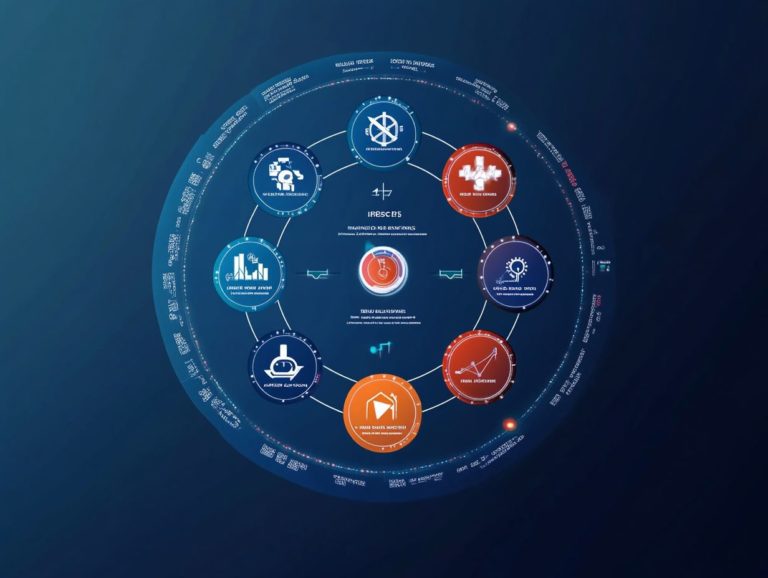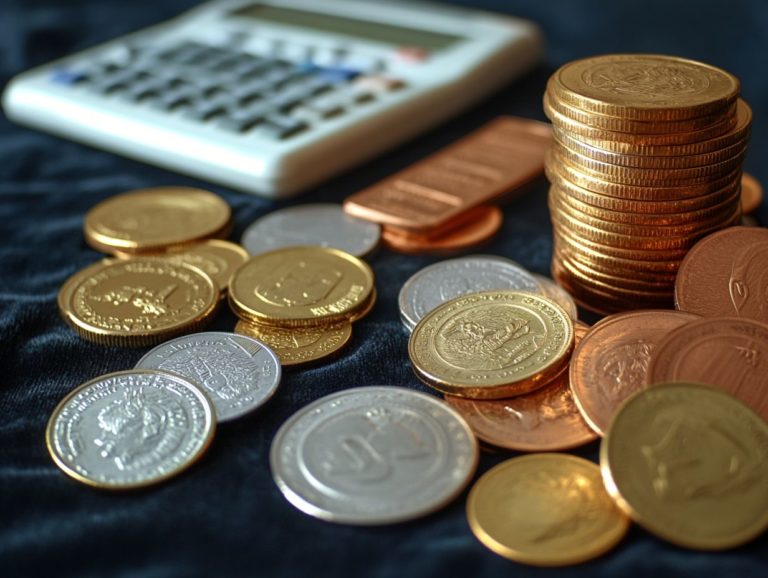How to Build a Resilient Precious Metals Portfolio
Precious metals have long captured the imagination, cherished not only for their exquisite allure but also for their remarkable potential as solid investments.
In an era marked by market volatility and rising inflation, savvy investors are turning to gold, silver, platinum, and palladium to strengthen their investments.
We ll cover the various types of precious metals, the unique advantages they provide, and strategies for crafting a resilient portfolio that aligns with your investment goals.
Let s explore common pitfalls to avoid, ensuring your journey into the world of precious metals is as rewarding as possible.
So, dive in and discover how to navigate this golden opportunity with confidence!
Contents
- Key Takeaways:
- Understanding Precious Metals
- Benefits of Diversifying with Precious Metals
- Factors to Consider When Building a Precious Metals Portfolio
- Strategies for Building a Resilient Precious Metals Portfolio
- Mistakes to Avoid When Building a Precious Metals Portfolio
- Frequently Asked Questions
- What are the benefits of building a resilient precious metals portfolio?
- How do I determine the right mix of precious metals for my portfolio?
- What are some common types of precious metals to include in a portfolio?
- How can I purchase and store physical precious metals?
- Are there any risks involved in investing in precious metals?
- What are some ways to monitor and adjust my precious metals portfolio?
- Ready to build your precious metals portfolio?
Key Takeaways:
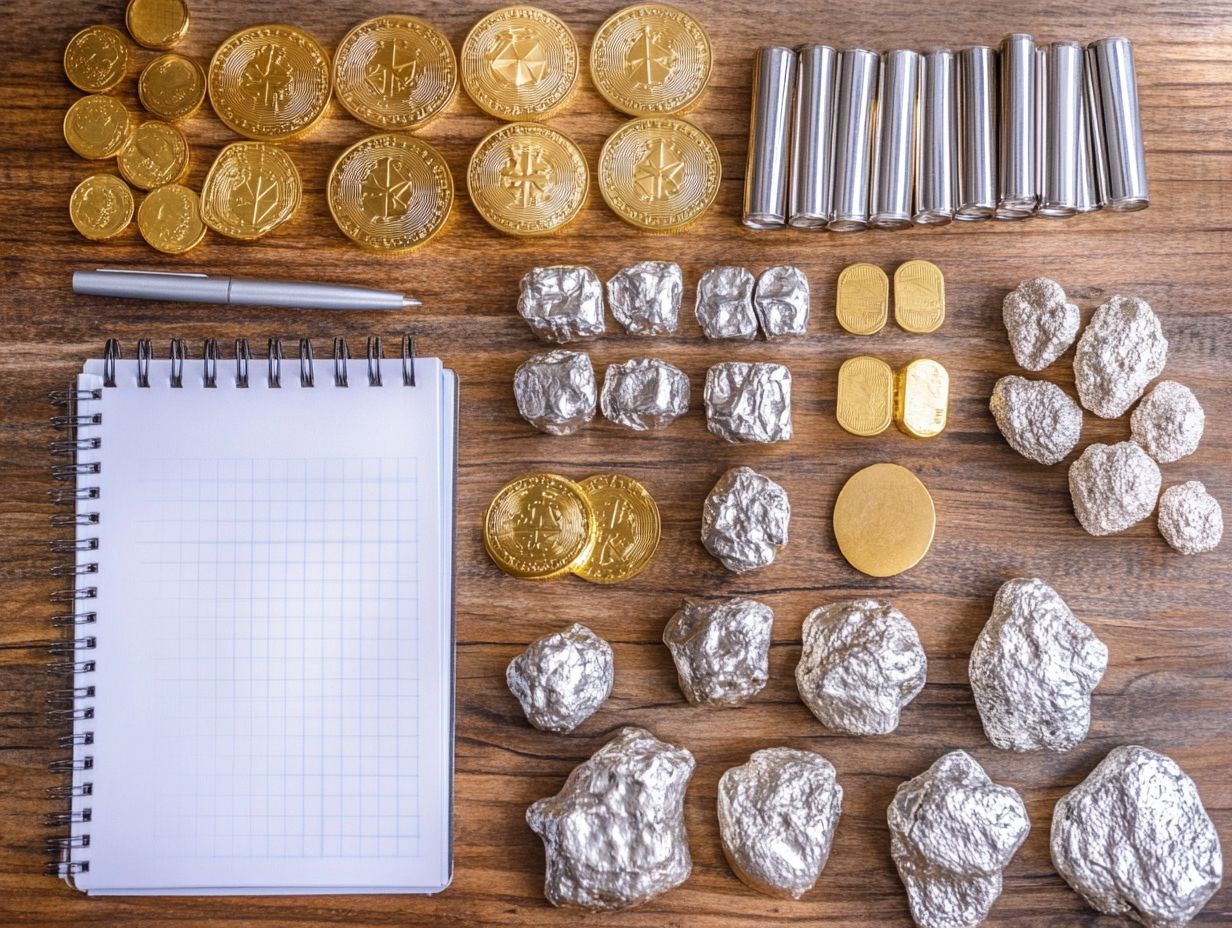
- Diversifying with precious metals can protect against market volatility and act as an inflation hedge.
- Consider your investment goals and risk tolerance when selecting precious metals.
- Implement strategies like regular investing, allocation, and rebalancing to strengthen your portfolio.
Understanding Precious Metals
Understanding precious metals is essential for investors looking to navigate the unpredictable market and maximize long-term wealth potential. Gold, silver, platinum, and palladium have proven themselves as valuable assets, especially during economic uncertainties.
Adding these metals to your portfolio diversifies your investments, hedges against inflation, and creates a safe haven for your capital. Being well-versed in the status of precious metals within financial markets can shape your investment strategies and help you reach your financial goals. If you’re considering this, learn how to invest in gold for retirement to enhance your strategy.
Types of Precious Metals and Their Properties
Consider various types of precious metals that could enhance your investment portfolio: gold, silver, platinum, and palladium. Each metal has unique properties and market behaviors that can influence your investment decisions.
Gold, often regarded as a safe-haven asset, has a reputation for retaining value during economic downturns. Silver, with its industrial applications and accessible price point, attracts a wider range of investors. Platinum, while rarer, offers advantages due to high demand in the automotive and jewelry sectors. Palladium has gained traction for its role in catalytic converters, driving up its popularity.
By understanding their historical performance, collectible value, and market value, you can craft a tailored investment strategy that manages risks while taking advantage of evolving market conditions.
Benefits of Diversifying with Precious Metals
Investing in precious metals offers many benefits. One notable advantage is the diversification advantage, which can significantly enhance your overall portfolio performance.
This strategy safeguards against economic uncertainties, providing robust protection for your financial future.
Protection Against Market Volatility
Precious metals provide a robust shield against market volatility, serving as a safe haven during turbulent financial periods.
Consider the 2008 financial crisis; it became clear that gold and silver held their value while equities fell. As global markets spiraled downward, the price of gold surged, making it a coveted asset for those wanting to preserve their wealth. Events like Germany’s hyperinflation in the early 1920s further highlight how gold emerged as a reliable store of value when fiat currencies faltered.
By incorporating these assets into your investment portfolio, you can navigate the unpredictable nature of the markets and effectively safeguard your financial future.
Start exploring your options today to secure your financial future!
Inflation Hedge

One of the primary reasons you might choose precious metals is their remarkable ability to serve as a hedge against inflation, especially during times of economic uncertainty.
As inflation rises, the purchasing power of your currency diminishes. This means you can buy less with the same amount of money over time. Such conditions prompt individuals to seek reliable stores of value that withstand fluctuations in fiat currencies. Financial advisors often highlight that while stocks and bonds may stumble during inflationary periods, precious metals like gold and silver tend to maintain their value or even appreciate.
Recent market trends indicate that as inflation persists, more investors are gravitating toward these traditional assets. They recognize the historical resilience of metals as a safe haven amidst tumultuous financial climates.
Factors to Consider When Building a Precious Metals Portfolio
- Your investment goals
- Your risk tolerance
- The overall balance of your investment options
When constructing a precious metals portfolio, it s crucial to take these factors into account. This thoughtful approach will ensure that your portfolio aligns with your financial aspirations and risk profile.
Investment Goals and Risk Tolerance
Defining your investment goals and understanding your risk tolerance are essential steps in crafting a successful precious metals portfolio that aligns with your financial aspirations.
As an investor, you might prioritize different outcomes whether it’s wealth preservation, diversification, or potential capital appreciation which will directly influence your choice of metals such as gold, silver, or platinum. If long-term growth is your aim, you may find yourself leaning toward gold, known for its stability. Conversely, if you’re seeking potentially high returns and can handle a bit more volatility, silver might catch your eye. It’s also wise to consider how to prepare for a precious metals market crash when making your investment decisions.
It’s also important to implement risk management strategies to protect your investments from market fluctuations. Being aware of capital gains tax implications can guide your timing for buying or selling these metals. Additionally, knowing how to create an exit strategy for precious metals ensures that your overall strategy remains profitable and tax-efficient, aligning with your unique financial goals.
Types of Precious Metals to Include
You should consider diversifying your investment portfolio with a selection of precious metals. These include gold, silver, platinum, and palladium. Each metal offers unique advantages that can enhance your investment strategy.
These precious metals act as a hedge against inflation and boast distinct characteristics beneficial in different market scenarios. For example, gold is often regarded as a safe haven during economic downturns, while silver tends to have strong industrial demand, resulting in increased volatility and potential rewards for traders. If you’re considering these assets, knowing how to liquidate precious metals is essential. Platinum, being rarer, is frequently utilized in automotive catalytic converters, presenting unique investment opportunities linked to global manufacturing trends.
You have the option of investing in bullion, which typically comes in the form of bars or coins valued primarily by weight, or numismatic pieces that carry additional value due to their rarity and historical significance, appealing to a more specialized collector base.
Strategies for Building a Resilient Precious Metals Portfolio
Building a resilient precious metals portfolio requires effective investment strategies. You should consider:
- Dollar-cost averaging: Investing a fixed amount regularly to reduce the impact of market volatility.
- Ensuring proper allocation across different metals.
- Committing to regular rebalancing to maintain your target allocation.
These practices will help you navigate market fluctuations with confidence and fortify your investments for long-term success.
Start building your precious metals portfolio today! Consult with a financial advisor for personalized advice tailored to your investment goals for precious metals.
Dollar-Cost Averaging

Dollar-cost averaging is a savvy investment strategy that empowers you to reduce risks by buying a fixed amount of an investment at regular intervals, regardless of market conditions.
In terms of investing in precious metals, this approach enables you to build a more resilient portfolio without excessive worry about short-term price fluctuations. For instance, when market prices soar, you might opt to buy smaller amounts of gold or silver. Conversely, during price dips, you can seize the opportunity to purchase at lower rates, effectively averaging out your cost per ounce. Additionally, learning how to use gold to diversify your portfolio can enhance your investment strategy.
This strategy is especially helpful in volatile markets, where precious metals can experience dramatic price swings due to global political events or economic uncertainties. By employing dollar-cost averaging, you not only smooth out the bumps of market volatility but also adopt a disciplined approach to acquiring these valuable assets over time. For more detailed guidance, check out how to build a precious metals portfolio?
Allocation and Rebalancing
Proper allocation and regular rebalancing are vital in managing your precious metals portfolio, helping to keep it in harmony with your investment objectives.
To nail down the right allocation, consider a range of factors such as market trends, economic indicators, and your own risk tolerance. It is important to customize this allocation to mirror your personal financial goals, as different metals can behave distinctively under varying market conditions.
As time goes on, rebalancing becomes essential; it allows you to adjust your holdings in response to market shifts, preventing both overexposure and underexposure to certain assets. By consistently reviewing and fine-tuning your allocations, you can better protect your investments while positioning yourself to seize new opportunities.
Mistakes to Avoid When Building a Precious Metals Portfolio
Avoiding common mistakes while constructing your precious metals portfolio is essential for achieving your investment goals and managing risks effectively. By being mindful of potential pitfalls, you can ensure that your financial strategy remains robust and aligned with your objectives.
Over-allocating to One Metal
Over-allocating to a single precious metal can expose you to unnecessary risks and undermine the advantages of a well-diversified portfolio.
When you concentrate your holdings in one type of metal, like gold or silver, you might inadvertently heighten your vulnerability to market fluctuations specific to that asset. For example, if geopolitical tensions escalate or supply chain disruptions arise, the value of your chosen metal could plummet. To mitigate these risks, consider learning how to use ETFs for precious metals investment, which can help diversify your portfolio and reduce potential financial losses.
Conversely, adopting a diversified approach allows you to spread your investments across various metals such as platinum, which is used in jewelry; palladium, often used in cars; and copper, known for its electrical applications which tend to respond differently to economic changes. Additionally, if you find yourself with inherited metals, it’s important to know what to do with inherited precious metals. By doing so, you not only mitigate potential losses but also enhance your chances of capitalizing on upward trends in different markets, ultimately leading to more stable financial outcomes.
Not Considering Storage and Insurance Costs
Neglecting to factor in storage and insurance costs can significantly impact the overall profitability of your precious metals investment portfolio and undermine your capital preservation efforts.
You should explore various storage options, such as safe deposit boxes, home safes, or professional vault services, each with its own set of fees. The choice you make regarding storage can greatly affect the security of your assets and the convenience of access when you need them. If you’re considering your investment choices, learning how to invest in gold can be a valuable addition to your strategy. Insuring your precious metals not only protects against theft and damage but also provides peace of mind, particularly during market fluctuations. Understanding these costs is essential, as they can either diminish your potential returns or strengthen your overall investment strategy.
Frequently Asked Questions

What are the benefits of building a resilient precious metals portfolio?
A resilient precious metals portfolio protects you against inflation, currency devaluation, and economic downturns.
It also diversifies your investments beyond stocks and bonds.
How do I determine the right mix of precious metals for my portfolio?
The right mix depends on your investment goals, risk tolerance, and time frame.
Consider talking to a financial advisor for tailored advice.
What are some common types of precious metals to include in a portfolio?
Gold, silver, platinum, and palladium are popular choices for precious metals portfolios.
Each metal has unique benefits that enhance your investment diversity.
How can I purchase and store physical precious metals?
You can buy physical precious metals from trusted dealers or online platforms.
For storage, consider using a home safe or a secure storage facility.
Are there any risks involved in investing in precious metals?
Investing in precious metals carries risks like market price fluctuations and potential liquidity issues.
It’s crucial to research and understand these risks before investing.
What are some ways to monitor and adjust my precious metals portfolio?
Regularly check market prices and stay informed about economic and political changes that might affect your investments.
Adjust your portfolio as needed to align with your goals and risk tolerance.
Ready to build your precious metals portfolio?
Start today by researching your options and consider reaching out for more information!










